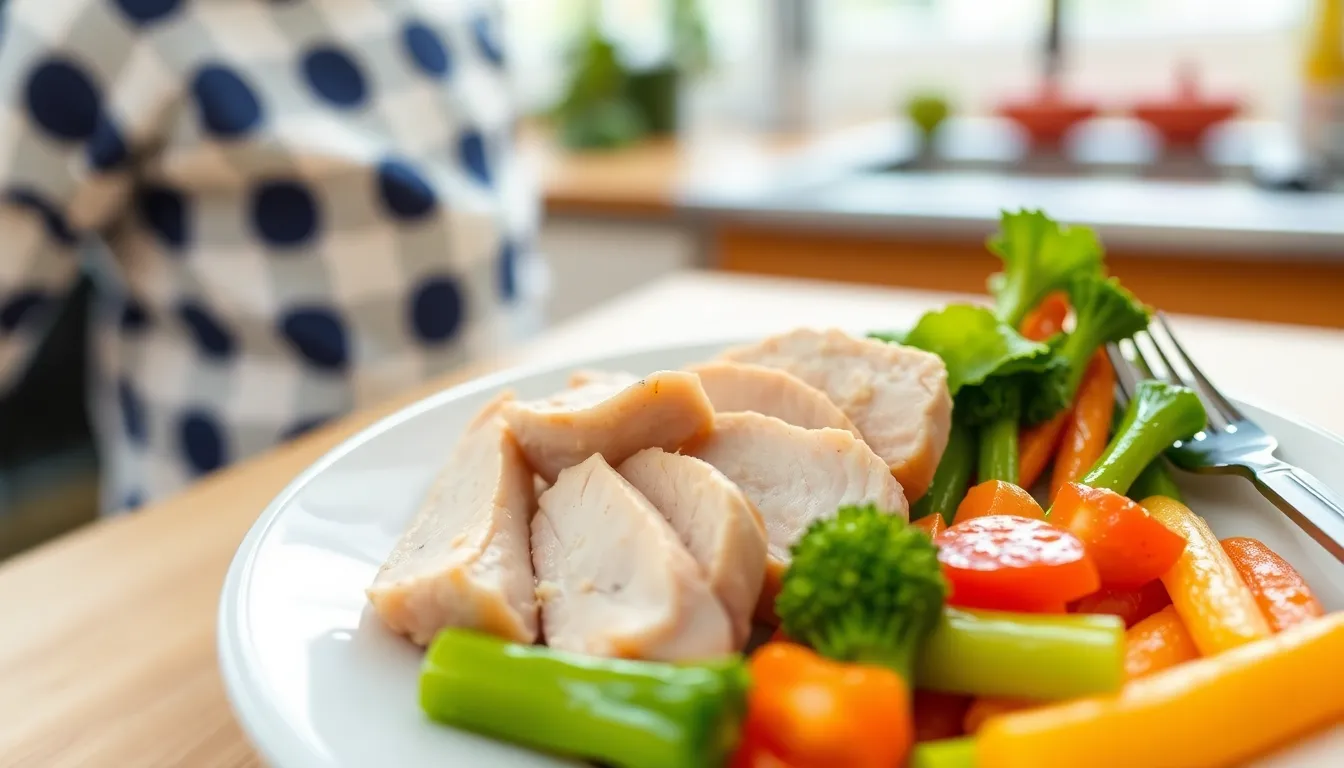Baby-led weaning is all the rage these days, and for good reason. It’s not just about giving little ones a chance to explore new flavors; it’s a culinary adventure that could turn them into mini food critics. And what better way to kick off this journey than with chicken? Packed with protein and oh-so-versatile, chicken can be a game-changer for those tiny taste buds.
Table of Contents
ToggleWhat Is Chicken Baby Led Weaning?
Chicken baby led weaning focuses on introducing chicken as a wholesome food option for infants. This method encourages freedom and exploration during mealtime.
Definition and Overview
Baby-led weaning is an approach where infants self-feed instead of relying on purees. It aims to promote independence and develop motor skills while enjoying solid food. Chicken serves as a nutritious foundation due to its high protein content and adaptability. Parents choose cooked chicken pieces that are appropriately sized for little hands. Offering a variety of preparations, such as baked or shredded, can enhance the experience. Overall, chicken baby led weaning fosters autonomy while introducing favorable eating habits.
Benefits of Baby Led Weaning with Chicken
Baby led weaning with chicken presents numerous advantages. It encourages sensory exploration, allowing infants to engage their senses by touching and tasting. Protein-rich chicken aids in growth and development, providing essential nutrition. Children exposed to a variety of flavors early on often develop a wider palate. Eating together as a family promotes social interaction and healthy dining habits. Additionally, this method typically leads to less fussiness at mealtimes. Parents report that meals become enjoyable experiences rather than stressful obligations when incorporating chicken into baby led weaning.
Preparing Chicken for Baby Led Weaning


Preparing chicken for baby-led weaning involves selecting appropriate cuts and using safe cooking methods. Both aspects ensure the chicken is nutritious and easy for infants to handle.
Best Chicken Cuts for Babies
Tender cuts work best for babies. Chicken breast fillets provide a lean source of protein, while thighs offer moisture and flavor. Skinless options minimize added fat. For improved ease, remove bones and cartilage. Strips or cubes of cooked chicken allow for better grip and chewing. Consider marinating lightly with herbs or spices to enhance taste without overwhelming the palate. Chicken pieces should be small enough to prevent choking yet large enough for infants to grasp.
Safe Cooking Methods
Baking yields moist chicken while preserving nutrients. Steaming chicken retains flavors and tenderness, making it easier for babies to chew. Boiling can also create soft, shreds perfect for little eaters. Grilling adds flavor but requires careful monitoring to avoid charred bits. Always ensure chicken reaches an internal temperature of 165°F to prevent foodborne illness. Cutting cooked chicken into age-appropriate sizes enhances safety while promoting self-feeding.
Introducing Chicken into Your Baby’s Diet
Introducing chicken into a baby’s diet provides essential nutrition and encourages self-feeding. With its versatility, chicken serves as an ideal first protein for young eaters.
First Steps to Introducing Chicken
Begin with well-cooked, tender cuts of chicken such as breast fillets or thighs. Cut the chicken into strips or small cubes to enhance grip and ease of handling. Offer chicken around six months of age when the baby shows signs of readiness for solid foods. Serve it plain without added salt, spices, or sauces to maintain simplicity. Gradually introduce small amounts and observe the baby’s response to flavors and textures. Incorporating chicken during family meals fosters a sociable eating experience, making shared dining enjoyable for everyone.
Monitoring for Allergies
Watch for any signs of allergies when introducing chicken. Common symptoms may include rashes, vomiting, or changes in behavior. Introduce chicken independently, avoiding other new foods simultaneously to identify potential reactions. Keep a food diary to document what the baby eats and any observed symptoms. If any reactions occur, consult a pediatrician to ensure safe nutrition moving forward. Monitoring closely instills confidence in the baby-led weaning process, making it easier for caregivers to support dietary changes.
Creative Chicken Recipes for Babies
Exploring chicken recipes for babies encourages healthier eating habits. Chicken offers versatility and nutrition, catering to young palates.
Chicken Purees and Finger Foods
Chicken purees make for a smooth introduction to solid foods. Combining cooked chicken with steamed vegetables creates a nutritious blend. For finger foods, she can cut the chicken into strips or cubes, ensuring they’re easy to grip. Cooking methods like steaming or baking keep the texture tender. These preparations foster self-feeding skills and help infants explore flavors. Introducing chicken along with soft fruits, like avocados, offers varied tastes and textures. Maintaining safety remains essential; ensuring pieces are small and manageable helps avoid choking hazards.
Flavor Combinations for Chicken Dishes
Flavor combinations enhance chicken dishes for babies. Mixing chicken with sweet potatoes supports healthy development. Pairing shredded chicken with peas introduces delightful textures and colors. Combining chicken with mild spices, such as cumin or garlic powder, adds a subtle taste. Caregivers can also blend chicken with apples or pears for sweetness. These flavors encourage adventurous eating habits and develop a more refined palate. Using fresh herbs like basil, parsley, or thyme can also elevate the dish. Such combinations not only make meals enjoyable but also contribute vital nutrients.
Tips for Successful Chicken Baby Led Weaning
Successful chicken baby-led weaning relies on making mealtime enjoyable and encouraging self-feeding. These strategies foster a positive experience for both infants and caregivers.
Making Mealtime Enjoyable
Mealtime enjoyment creates a welcoming atmosphere for infants. Incorporating colorful plates and fun utensils makes the experience visually appealing. Create a designated eating space where the baby feels comfortable and relaxed. Family meals contribute to a sociable environment, allowing everyone to engage and model healthy eating habits. Sing songs or narrate stories during mealtime to spark interest in food. Keep distractions to a minimum, enabling babies to focus on their food and eating skills. Serve chicken in different shapes or sizes to maintain novelty and fun in each meal.
Encouraging Self-Feeding
Self-feeding empowers infants to explore textures and flavors independently. Start with chicken strips or soft cubes, easy for little hands to grasp. Allow babies to lead their discovery with food, building confidence in their abilities. Provide different cooking methods like baking or steaming, enhancing chicken’s softness for better handling. Encourage infants to experiment with various combinations like chicken and steamed veggies. Offer praise or encouragement as they navigate self-feeding, reinforcing positive behavior. Consistent mealtime routines help establish familiarity, making self-feeding a natural part of their culinary journey.








